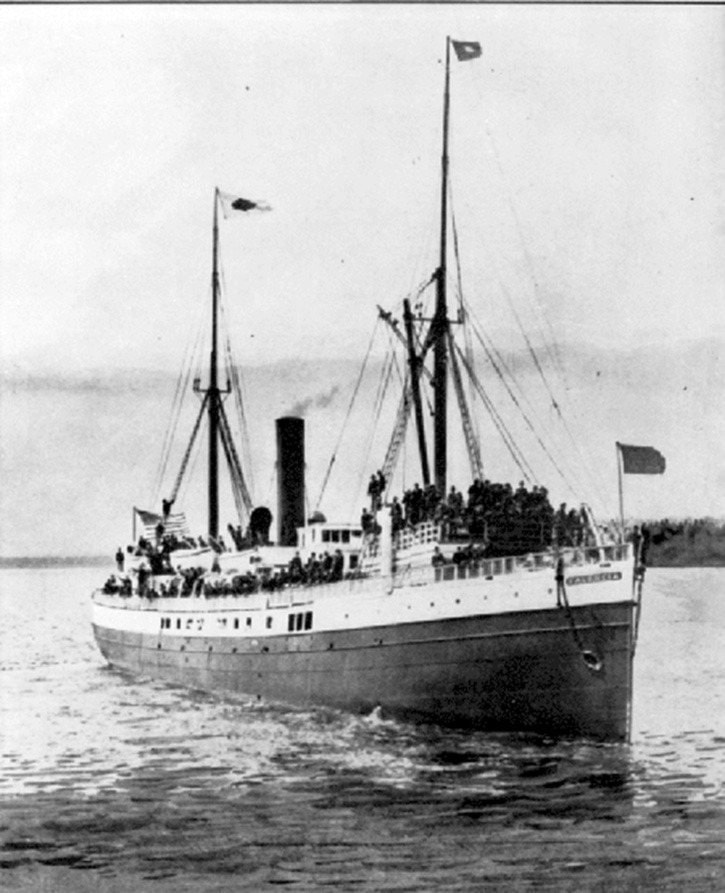Last summer, many out-of-town visitors who came to the Maritime Museum of B.C. would chat with me about their experiences on Vancouver Island. Some had a distinctive look to them – recently tanned and slightly unkempt. They were not beach-goers, but rather intrepid folks who had just hiked the West Coast Trail.
Few of them had any idea of its origin, but I suspect that anyone who has been caught in bad weather on the West Coast Trail would understand its real importance: it was designed to save lives.
One particular tragedy prompted the Canadian government to hew and hack the trail out of the Island’s rugged landscape. This was the horrific sinking of the steamship Valencia.
Valencia was based out of San Francisco, and had been serving the Pacific Coast Steamship Service for four years as a back-up vessel on a route up to Alaska, when in January 1906 she was diverted to the San Francisco-Seattle run. This route included a stop in Victoria.
Built in 1884, she was a not a new ship, nor a particularly advanced one. Although she featured four watertight compartments to protect the engine and boiler room, Valencia was not fitted with a double bottom and her bulkheads were not particularly well-braced.
Approximately 65 crew members and 110 paid passengers were onboard the ship when she set out from San Francisco on Jan. 20, 1906.
There were calm seas and fair skies at first, but as they sailed north the weather thickened with rain and haze. The stars were obscured, and so the navigators had to rely on dead reckoning (which relies on estimated speeds and compass courses to determine location in an imprecise way) to find their way along the coast.
It was this imprecision that caused the Valencia to overshoot the entrance to the Strait of Juan de Fuca and suddenly run into a rock on the southwest coast of Vancouver Island, about 18 kilometres southeast of Cape Beale. Water began to pour into the wounded hull, and when the next great swell pushed the ship over the rock and drove her towards shore, the captain ordered that the boat be deliberately beached in order to save her from sinking.
She wound up jammed on a reef about 80 meters from shore in about four fathoms of water. There were huge, crashing waves and winds of 55 km/h battering the ship. The coastline was sheer cliffs, and no sign of inhabitation other than a rough trail, hacked through the dense forest, which bore a haphazard telegraph/telephone line that connected the Carmanah Light Station with Bamfield Creek and Cape Beale.
The horrifying deep crunch of twisting metal would have shaken the Valencia and all her passengers to the very core, but it was when the engines and therefore the lights went out onboard that people began to panic.
Without any order to abandon the ship, passengers began to get into the six lifeboats that were standing by. They called out to lower the boats, and in the darkness and confusion the davit crews didn’t realize these were not official orders. All six boats were lowered within about 30 minutes, and that is when the real horror began.
Of the six lifeboats, three were caught in accidents whilst being lowered which emptied all the passengers into the water. All aboard were lost, save one crew member. Two more were successfully launched but capsized in the waves. Only nine survivors managed to make it to shore and climb the sheer rock cliffs the next morning. The last lifeboat simply drifted away and disappeared, to be found 27 years later adrift in Barkley Sound. The Maritime Museum of B.C. has its nameplate in its collection.
In the light of morning, the Valencia began to break apart on the reef. Meanwhile, the survivors onshore found the telegraph line and followed it through the woods, not knowing where they were going or indeed where they were.
Finally they found a lineman’s shack with a telephone inside. They hooked it up and managed to contact the Carmanah Station which in turn sent the news along to Victoria.
Though three rescue vessels steamed out towards the Valencia, they could not approach the wreck without grounding themselves. Approaching overland through the thick wilderness was far too slow and laborious, and the efforts came too late for most.
Only 37 passengers were saved from the waves, and as the ship broke apart women and children were clinging to the rigging, wailing before being washed to their deaths. Not a single woman or child survived the wreck, which had taken 36 hours to finally sink.
The tragedy of the Valencia emphasised the inaccessibility of the southwest coast of Vancouver Island (known as the Graveyard of the Pacific), and the near impossibility of rescue efforts in that region.
It was thus that the West Coast Trail was conceived as a way of reaching just such shipwrecks and preventing further losses of human life.
The building of the trail is the subject of the next column, so stay tuned for Part 2.
•••
Kate Humble is an historian and the education curator for the Maritime Museum of B.C. Questions and ideas for future columns are welcome by email at khumble@mmbc.bc.ca.



